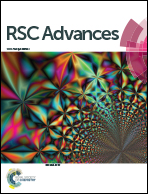Direct writing of a conducting polymer pattern in aqueous solution by using an ultrashort laser pulse†
Abstract
A new method for the polymerization and patterning of a conducting polymer by using a femtosecond laser is presented. In this research, pyrrole-3-carboxylic acid (PCA), an acid derivative of pyrrole, was used because of its higher water solubility and favorable adhesion to the glass surface. The PCA pattern was fabricated in a microfluidic channel between gold electrodes and comprised micro-/nano structures. The optimized parameters of the femtosecond laser were investigated for obtaining sharp and defined conducting polymer patterns. The aqueous state of the polymerization enhanced the possibility of applying additional dopants for extending the functionality of the pattern, including embedding of bio molecules. The generated patterns of the conducting polymer were observed and evaluated by atomic force microscopy and conductivity measurements.



 Please wait while we load your content...
Please wait while we load your content...